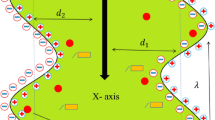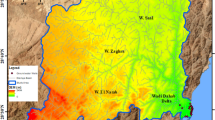Abstract
Descriptions of chemical transformation kinetics and hydrologic transport need to be coupled to understand the composition of flowing waters. The coupling of a bimolecular transformation reaction (reactant 1 + reactant 2 → product; rate \( r = \kappa c_{1} c_{2} \)) with spatially heterogeneous subsurface flows is addressed here. The flow microstructure—that controls the spreading rate of solutes and the mean reactant concentrations (C 1, C 2)—creates concentration microstructure whose intensity is characterized by the variances \( \sigma_{{c_{1} }}^{2} \), \( \sigma_{{c_{2} }}^{2} \), and the cross-covariance \( \overline{{c_{1} c_{2} }} \). In addition to the macroscopic overlap of the reactants, that is quantified by the product of the mean concentrations that are routinely modeled using effective dispersion coefficients \( D_{ij} \), the concentration microstructure plays an important role in determining reaction macro-kinetics as the mean reaction rate is \( \overline{r} = \kappa (C_{1} C_{2} + \overline{{c_{1} c_{2} }} ) \). For initially non-overlapping reactants \( \overline{{c_{1} c_{2} }} + C_{1} C_{2} = 0 \) and \( \overline{r} = 0 \) under pure advection. It is shown that due to the action of local dispersion, at large time, the \( \overline{{c_{1} c_{2} }} \) budget is characterized by a balance between its rate of production and dissipation, which results in \( \overline{{c_{1} c_{2} }} \approx 2\tau D_{ij} ({{\partial C_{1} } \mathord{\left/ {\vphantom {{\partial C_{1} } {\partial x_{i} )({{\partial C_{2} } \mathord{\left/ {\vphantom {{\partial C_{2} } {\partial x_{j} )}}} \right. \kern-0pt} {\partial x_{j} )}}}}} \right. \kern-0pt} {\partial x_{i} )({{\partial C_{2} } \mathord{\left/ {\vphantom {{\partial C_{2} } {\partial x_{j} )}}} \right. \kern-0pt} {\partial x_{j} )}}}} \), where τ is the dissipation time-scale characteristic to the destruction of concentration fluctuation by local dispersion. This results in \( \overline{r} = \kappa_{\text{eff}} C_{1} C_{2} \), where \( \kappa_{\text{eff}} \approx \kappa [1 + 2\tau D_{ij} ({{\partial { \ln }C_{1} } \mathord{\left/ {\vphantom {{\partial { \ln }C_{1} } {\partial x_{i} )({{\partial { \ln }C_{2} } \mathord{\left/ {\vphantom {{\partial { \ln }C_{2} } {\partial x_{j} )}}} \right. \kern-0pt} {\partial x_{j} )}}}}} \right. \kern-0pt} {\partial x_{i} )({{\partial { \ln }C_{2} } \mathord{\left/ {\vphantom {{\partial { \ln }C_{2} } {\partial x_{j} )}}} \right. \kern-0pt} {\partial x_{j} )}}}}] \), which accounts for the influence of concentration microstructure and small-scale mixing on the macroscopic bimolecular kinetics. The effective rate parameter κeff is greater than the intrinsic rate constant κ measured under well-mixed conditions if the macroscopic concentration gradients have the same sign (initially overlapping reactants). For the initially non-overlapping reactants which result in macroscopic gradients having opposite signs, κ eff < κ. The macroscopic reactant concentration gradients, effective dispersion coefficients, and the dissipation time-scale control the reaction macro-kinetics, in addition to the intrinsic rate constant κ and the mean reactant concentrations. The formulation for reaction macro-kinetics developed here helps explain previously reported disparities between laboratory and field-scale transformation rates and also provides a way to represent the influence of reactant concentration microstructure in large-scale descriptions of reactive transport.





















Similar content being viewed by others
References
Acharya RC, Valocchi AJ, Werth CJ, Willingham TW (2007) Pore-scale simulation of dispersion and reaction along a transverse mixing zone in two-dimensional media. Water Resour Res 43:W10435. doi:10.1029/2007WR005969
Ames WF (1992) Numerical methods for partial differential equations, 3rd edn. Academic Press, USA
Anmala J (2000) Mixing and bimolecular reaction kinetics in heterogeneous porous media flows. Ph.D thesis, Georgia Institute of Technology
Anmala J, Kapoor V (2012) Mixing and bimolecular reaction kinetics in a plane Poisseulle flow. Flow Turbul Combust 88:387–405
Battiato I, Tartakovsky DM (2011) Applicability regimes for macroscopic models of reactive transport in porous media. J Contam Hydrol 120–121:18–26
Battiato I, Tartakovsky DM, Tartakovsky AM, Scheibe TD (2009) On breakdown of macroscopic models of mixing-controlled heterogeneous reactions in porous media. Adv Water Resour 32:1664–1673
Battiato I, Tartakovsky DM, Tartakovsky AM, Scheibe TD (2011) Hybrid models of reactive transport in porous and fractured media. Adv Water Resour 34:1140–1150
Cirpka OA, Kitanidis PK (2000a) Characterization of mixing and dilution in heterogeneous aquifers by means of local temporal moments. Water Resour Res 36(5):1221–1236
Cirpka OA, Kitanidis PK (2000b) An advective dispersive streamtube approach for the transfer of conservative tracer data to reactive transport. Water Resour Res 36(5):1209–1220
Dentz M, Borgne TL, Englert A, Bijeljic B (2011) Mixing, spreading and reaction in heterogeneous media: a brief review. J Contam Hydrol 120–121:1–17
Dykaar B, Kitanidis PK (1992) Determination of effective hydraulic conductivity in heterogeneous porous media using a numerical spectral approach, 1, Method. Water Resour Res 28(4):1155–1166
Friedly JC, Davis JA, Kent DB (1995) Modeling hexavalent chromium reduction in groundwater in field-scale transport and laboratory batch experiments. Water Resour Res 31(11):2783–2794
Gelhar LW (1993) Stochastic subsurface hydrology. Prentice-Hall, Englewood-Cliffs
Gelhar LW, Axness CL (1983) Three-dimensional stochastic analysis of macrodispersion in aquifers. Water Resour Res 19(1):161–180
Kapoor V, Anmala J (1998) Lower bounds on scalar dissipation rate in bounded rectilinear flows. Flow Combust Turbul 60(2):125–156
Kapoor V, Gelhar LW (1994a) Transport in three-dimensionally heterogeneous aquifers. 1. Dynamics of concentration fluctuations. Water Resour Res 30(6):1775–1788
Kapoor V, Gelhar LW (1994b) Transport in three-dimensionally heterogeneous aquifers. 2. Predictions and observations of concentration fluctuations. Water Resour Res 30(6):1789–1801
Kapoor V, Kitanidis PK (1997) Advection-diffusion in spatially random flows: formulation of concentration covariance. Stoch Hydrol Hydraul 11(5):397–422
Kapoor V, Kitanidis PK (1998) Concentration fluctuations and dilution in aquifers. Water Resour Res 34(5):1181–1194
Kapoor V, Gelhar LW, Wilhelm FM (1997) Bimolecular second order reactions in spatially varying flows: segregation induced scale dependence of transformation. Water Resour Res 33(4):527–536
Kapoor V, Jafvert CT, Lyn DA (1998) Experimental study of a bimolecular reaction in Poiseuille flow. Water Resour Res 34(8):1997–2004
LeBlanc DR, Garabedian SP, Hess KM, Gelhar LW, Quadri RD, Stollenwerk KG, Wood WW (1991) Large-scale natural gradient tracer test in sand and gravel, Cape Cod, Massachusetts: 1. Experimental design and observed tracer movement. Water Resour Res 27(5):895–910
Lichtner PC, Tartakovsky DM (2003) Stochastic analysis of effective rate constant for heterogeneous reaction. Stoch Environ Res Risk Assess 17:419–429
Luo J, Dentz M, Carrera J, Kitanidis P (2008) Effective reaction parameters for mixing controlled reactions in heterogeneous media. Water Reour Res 44:W02416. doi:10.1029/2006WR005658
Mo Z, Friedly JC (2000) Local reaction and diffusion in porous media transport models. Water Resour Res 36(2):431–438
Molz FJ, Widdowson MA (1988) Internal inconsistencies in dispersion-dominated models that incorporate chemical and microbial kinetics. Water Resour Res 24(4):615–619
Pannone M, Kitanidis PK (1999) Large-time behavior of concentration variance and dilution in heterogeneous formations. Water Resour Res 35(3):623–634
Raje D, Kapoor V (2000) Experimental study of bimolecular reaction kinetics in porous media. Environ Sci Tech 34:1234–1239
Semprini L, McCarty PL (1991) Comparison between model simulations and field results for in situ biorestoration of chlorinated aliphatics: part 1. Biostimulation of methanotrophic bacteria. Groundwater 29(3):365–374
Srinivasan G, Tartakovsky DM, Robinson BA, Aceeves AB (2007) Quantification of uncertainty in geochemical reactions. Water Resour Res 43:W12415. doi:10.1029/2007WR006003
Sturman PJ, Stewart PS, Cunningham AB, Bouwer EJ, Wolfram JH (1995) Engineering scale-up of in situ bioremediation processes: a review. J Contam Hydrol 19:171–203
Wang J, Kitanidis PK (1999) Analysis of macrodispersion through volume averaging: comparison with stochastic theory. Stoch Env Res Risk Assess 13:66–84
Webb BW, Walling DE (1996) Water quality, II, chemical characteristics. In: Petts G, Calow P (eds) River flows and channel forms. Blackwell, Cambridge, Chap. 6, pp 102–129
Author information
Authors and Affiliations
Corresponding author
Rights and permissions
About this article
Cite this article
Anmala, J., Kapoor, V. Dynamics of mixing and bimolecular reaction kinetics in aquifers. Stoch Environ Res Risk Assess 27, 1005–1020 (2013). https://doi.org/10.1007/s00477-012-0679-5
Published:
Issue Date:
DOI: https://doi.org/10.1007/s00477-012-0679-5




